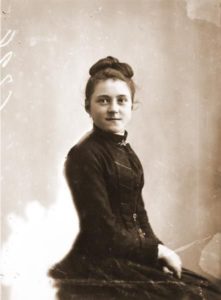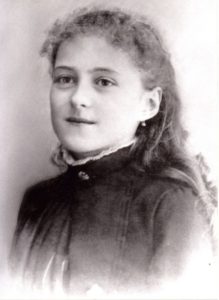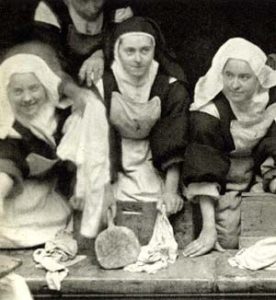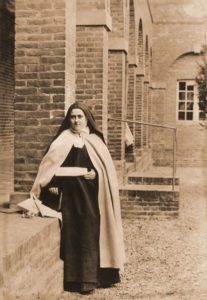
Audio Player
Messages of Saint Teresa of the Child Jesus to Clemente Domínguez y Gómez, today Pope Saint Gregory XVII, the Very Great
 12th of December 1969
12th of December 1969
Saint Teresa of the Child Jesus and of the Holy Face
(She said to Clemente Domínguez:) “My children, whenever you kiss Jesus’ Divine Countenance you will say: ‘Adorable Face of Our Lord Jesus Christ, vilely outraged by my sins, grant me the strength necessary to defend Thee with my life.’”
4th of January 1970
(Sacred Place of the Lentisco in El Palmar de Troya. Apparitions and Messages to Clemente Domínguez:)
Saint Teresa of the Child Jesus and of the Holy Face
“Everyone who bears the name ‘of the Holy Face’ dies in holiness, by the grace of Jesus Christ and the mediation of Mary, your Mother.”
Padre Pio de Pietrelcina
“My son: imitate the great adorers of the Holy Face, and above all Teresa of the Child Jesus and of the Holy Face, she who loved the Holy Face most. She therefore occupies a pre-eminent place beside Jesus.”

12th of December 1969
Saint Teresa of the Child Jesus and of the Holy Face
(She said to Clemente Domínguez:) “My children, whenever you kiss Jesus’ Divine Countenance you will say: ‘Adorable Face of Our Lord Jesus Christ, vilely outraged by my sins, grant me the strength necessary to defend Thee with my life.’”
4th of January 1970
(Sacred Place of the Lentisco in El Palmar de Troya. Apparitions and Messages to Clemente Domínguez:)
Saint Teresa of the Child Jesus and of the Holy Face
“Everyone who bears the name ‘of the Holy Face’ dies in holiness, by the grace of Jesus Christ and the mediation of Mary, your Mother.”
Padre Pio de Pietrelcina
“My son: imitate the great adorers of the Holy Face, and above all Teresa of the Child Jesus and of the Holy Face, she who loved the Holy Face most. She therefore occupies a pre-eminent place beside Jesus.”
Biography of Saint Teresa of the Child Jesus and of the Holy Face
30th of September
 Model of Holiness without mystical phenomena. Nun. Doctress. Victim Soul.Apostle of the Holy Face and Inspirer of the Missionary Spirit.
Model of Holiness without mystical phenomena. Nun. Doctress. Victim Soul.Apostle of the Holy Face and Inspirer of the Missionary Spirit.
Born in Alençon, Orne, France, on the 2nd of January 1873, her parents were Saint Louis Joseph Martin and Saint Celia Martin née Guérin, both canonized by Pope Saint Gregory XVII the Very Great. She was the last of nine children, four of whom died very young. The first years of her life were marked by the happiness and warmth of the family home, protected by her parents and four elder sisters: Pauline, Mary, Leonie and Celine. On the 28th of August 1877 her mother died, and the little one came closer to her sister Pauline, choosing her as mother. Then the whole family moved to live in Lisieux, where on the 2nd of October 1882 her sister Pauline entered the Discalced Carmelites.
 Saint Teresa, from three years of age, made the resolution to refuse God nothing, and took pains to know and fulfil His divine will. Every evening Saint Teresa went out with her father for a walk and a visit to the Most Holy Sacrament in a different church. One day, when they were in the chapel of the convent of the Discalced Carmelites in Lisieux, her father told her: “Do you see, my queen? Behind the railings there are holy nuns always praising God.” From then on she felt strongly drawn to consecrate herself to God in the Carmel. Nonetheless, everyone always gave her the same reply: “You are too young.” In 1887, at fourteen years, she told her father of her decision to become a Carmelite, and he supported her holy aspiration. That same year, Saint Teresa went on pilgrimage to Rome accompanied by her father and other relatives, for the celebration of the golden jubilee of Pope Saint Leo XIII the Great’s Priestly Ordination. During the general audience, when Saint Teresa was kneeling at the Sovereign Pontiff’s feet, she boldly asked him: “Most Holy Father, in honour of your jubilee, allow me to enter Carmel at fifteen years of age.” The Vicar General of Lisieux, the pilgrims’ guide on that occasion, told the Pope, “This is a girl who wants to enter Carmel”. The Sovereign Pontiff, inclining his head until almost touching the girl’s face, said to her: “Come now, you will enter if the Good God wills.” Saint Teresa went on insisting, until two guards gently took her by her arms and drew her back. After blessing her, the Holy Father looked after her for a long while.
Saint Teresa, from three years of age, made the resolution to refuse God nothing, and took pains to know and fulfil His divine will. Every evening Saint Teresa went out with her father for a walk and a visit to the Most Holy Sacrament in a different church. One day, when they were in the chapel of the convent of the Discalced Carmelites in Lisieux, her father told her: “Do you see, my queen? Behind the railings there are holy nuns always praising God.” From then on she felt strongly drawn to consecrate herself to God in the Carmel. Nonetheless, everyone always gave her the same reply: “You are too young.” In 1887, at fourteen years, she told her father of her decision to become a Carmelite, and he supported her holy aspiration. That same year, Saint Teresa went on pilgrimage to Rome accompanied by her father and other relatives, for the celebration of the golden jubilee of Pope Saint Leo XIII the Great’s Priestly Ordination. During the general audience, when Saint Teresa was kneeling at the Sovereign Pontiff’s feet, she boldly asked him: “Most Holy Father, in honour of your jubilee, allow me to enter Carmel at fifteen years of age.” The Vicar General of Lisieux, the pilgrims’ guide on that occasion, told the Pope, “This is a girl who wants to enter Carmel”. The Sovereign Pontiff, inclining his head until almost touching the girl’s face, said to her: “Come now, you will enter if the Good God wills.” Saint Teresa went on insisting, until two guards gently took her by her arms and drew her back. After blessing her, the Holy Father looked after her for a long while.  Back in Lisieux, permission was soon granted her in spite of her age, and on the 9th of April 1888, Saint Teresa entered the Carmel. She herself says: “Everything seemed wonderful to me in the convent. I entered there to save souls, and above all to pray for Priests.” On the 10th of January 1889, the Saint received the Carmelite habit. On finishing her noviciate she made her profession on the 8th of September 1890. Saint Teresa’s life in the Carmel was marked by great fidelity to the Holy Rules. She had a great capacity for love, and did ordinary things with extraordinary perfection. Great interior trials and the sufferings of daily life forged her sanctity. With patience and diligence she fulfilled all the tasks she was given in the community. In 1893, Saint Teresa, endowed with an adult personality, was put in charge of the novices. In the year 1894 her father died, assisted by his daughter Celine, who was later also to enter the Discalced Carmel of Lisieux. In 1895, Saint Teresa began to write down the memoirs of her early life by order of Mother Agnes of Jesus, her sister Pauline’s name in religion.
Back in Lisieux, permission was soon granted her in spite of her age, and on the 9th of April 1888, Saint Teresa entered the Carmel. She herself says: “Everything seemed wonderful to me in the convent. I entered there to save souls, and above all to pray for Priests.” On the 10th of January 1889, the Saint received the Carmelite habit. On finishing her noviciate she made her profession on the 8th of September 1890. Saint Teresa’s life in the Carmel was marked by great fidelity to the Holy Rules. She had a great capacity for love, and did ordinary things with extraordinary perfection. Great interior trials and the sufferings of daily life forged her sanctity. With patience and diligence she fulfilled all the tasks she was given in the community. In 1893, Saint Teresa, endowed with an adult personality, was put in charge of the novices. In the year 1894 her father died, assisted by his daughter Celine, who was later also to enter the Discalced Carmel of Lisieux. In 1895, Saint Teresa began to write down the memoirs of her early life by order of Mother Agnes of Jesus, her sister Pauline’s name in religion.

On Holy Friday 1896, Saint Teresa went to bed very tired. Shortly afterwards she coughed up blood for the first time. Out of mortification she did not light her lamp; but the following day she verified that the handkerchief was soaked in blood. In spite of tuberculosis of the lungs, she continued her work. One of the Saint’s greatest sufferings was the cold. On winter nights the bed had only one blanket as covering, and she spent them shivering to the point that she felt herself dying. Meanwhile she also bore, likewise in silence, her increasing bodily deterioration owing to illness. On the 8th of July 1897, she had to be transferred to the infirmary, and when autumn came she felt that her life was ebbing away. The nurse always found her with hands joined and eyes raised to Heaven, and one day asked her: “What are you doing like that?” And the Saint answered: “Speaking with Jesus”. “What do you tell Him?” the nurse insisted. And she replied: “I don’t tell Him anything, I love Him”. Shortly before death she promised that she would spend her Heaven doing good to those on earth, and announced a shower of roses following her demise. The roses were the many conversions and miraculous cures thanks to her intercession. Saint Teresa of the Child Jesus and of the Holy Face died in the Discalced Carmel of Lisieux, France, on the 30th of September 1897, exclaiming: “Oh, I love Him! My God I love You!”

Saint Teresa of the Child Jesus was a sublime model of holy obedience and of exact fulfilment of daily duty in accordance with the Holy Rules of the religious Order. She suffered in silence, lived without complaint, and obeyed the superioresses in things which might even seem foolish, but did them because she perceived the voice of Christ in what she was told. She offered to God her illnesses for the conversion of sinners. She ardently desired to live a thousand years to serve God and souls better. She knew that her passage through this vale of tears was rooted in the fulfilment of God’s will. She went through a terrible dark night, which she bore in the greatest silence, deprived of all consolation. She aspired to sanctity and sought out her way to win Heaven by the path of spiritual infancy, namely the way of love, of trust, of abandonment and of hope. In the innermost depths of her soul, Saint Teresa felt a missionary vocation, which she put into practice with extraordinary efficacy inside Carmel by way of love, prayer and sacrifice. She was very devoted to the Holy Face of Jesus, in whom she delighted and to whom she made reparation by her prayers and sacrifices.
Beatified by Pope Saint Pius XI the Great on the 29th of April 1923. Canonized by the same Pope on the 17th of May 1925. Declared Doctress of the Church by Pope Saint Gregory XVII the Very Great on the 7th of October 1978.

Model of Holiness without mystical phenomena. Nun. Doctress. Victim Soul. Apostle of the Holy Face and Inspirer of the Missionary Spirit.
Born in Alençon, Orne, France, on the 2nd of January 1873, her parents were Saint Louis Joseph Martin and Saint Celia Martin née Guérin, both canonized by Pope Saint Gregory XVII the Very Great. She was the last of nine children, four of whom died very young. The first years of her life were marked by the happiness and warmth of the family home, protected by her parents and four elder sisters: Pauline, Mary, Leonie and Celine. On the 28th of August 1877 her mother died, and the little one came closer to her sister Pauline, choosing her as mother. Then the whole family moved to live in Lisieux, where on the 2nd of October 1882 her sister Pauline entered the Discalced Carmelites.

Saint Teresa, from three years of age, made the resolution to refuse God nothing, and took pains to know and fulfil His divine will. Every evening Saint Teresa went out with her father for a walk and a visit to the Most Holy Sacrament in a different church. One day, when they were in the chapel of the convent of the Discalced Carmelites in Lisieux, her father told her: “Do you see, my queen? Behind the railings there are holy nuns always praising God.” From then on she felt strongly drawn to consecrate herself to God in the Carmel. Nonetheless, everyone always gave her the same reply: “You are too young.” In 1887, at fourteen years, she told her father of her decision to become a Carmelite, and he supported her holy aspiration. That same year, Saint Teresa went on pilgrimage to Rome accompanied by her father and other relatives, for the celebration of the golden jubilee of Pope Saint Leo XIII the Great’s Priestly Ordination. During the general audience, when Saint Teresa was kneeling at the Sovereign Pontiff’s feet, she boldly asked him: “Most Holy Father, in honour of your jubilee, allow me to enter Carmel at fifteen years of age.” The Vicar General of Lisieux, the pilgrims’ guide on that occasion, told the Pope, “This is a girl who wants to enter Carmel”. The Sovereign Pontiff, inclining his head until almost touching the girl’s face, said to her: “Come now, you will enter if the Good God wills.” Saint Teresa went on insisting, until two guards gently took her by her arms and drew her back. After blessing her, the Holy Father looked after her for a long while.

Back in Lisieux, permission was soon granted her in spite of her age, and on the 9th of April 1888, Saint Teresa entered the Carmel. She herself says: “Everything seemed wonderful to me in the convent. I entered there to save souls, and above all to pray for Priests.” On the 10th of January 1889, the Saint received the Carmelite habit. On finishing her noviciate she made her profession on the 8th of September 1890. Saint Teresa’s life in the Carmel was marked by great fidelity to the Holy Rules. She had a great capacity for love, and did ordinary things with extraordinary perfection. Great interior trials and the sufferings of daily life forged her sanctity. With patience and diligence she fulfilled all the tasks she was given in the community. In 1893, Saint Teresa, endowed with an adult personality, was put in charge of the novices. In the year 1894 her father died, assisted by his daughter Celine, who was later also to enter the Discalced Carmel of Lisieux. In 1895, Saint Teresa began to write down the memoirs of her early life by order of Mother Agnes of Jesus, her sister Pauline’s name in religion.
On Holy Friday 1896, Saint Teresa went to bed very tired. Shortly afterwards she coughed up blood for the first time. Out of mortification she did not light her lamp; but the following day she verified that the handkerchief was soaked in blood. In spite of tuberculosis of the lungs, she continued her work. One of the Saint’s greatest sufferings was the cold. On winter nights the bed had only one blanket as covering, and she spent them shivering to the point that she felt herself dying. Meanwhile she also bore, likewise in silence, her increasing bodily deterioration owing to illness. On the 8th of July 1897, she had to be transferred to the infirmary, and when autumn came she felt that her life was ebbing away. The nurse always found her with hands joined and eyes raised to Heaven, and one day asked her: “What are you doing like that?” And the Saint answered: “Speaking with Jesus”. “What do you tell Him?” the nurse insisted. And she replied: “I don’t tell Him anything, I love Him”. Shortly before death she promised that she would spend her Heaven doing good to those on earth, and announced a shower of roses following her demise. The roses were the many conversions and miraculous cures thanks to her intercession. Saint Teresa of the Child Jesus and of the Holy Face died in the Discalced Carmel of Lisieux, France, on the 30th of September 1897, exclaiming: “Oh, I love Him! My God I love You!”

Saint Teresa of the Child Jesus was a sublime model of holy obedience and of exact fulfilment of daily duty in accordance with the Holy Rules of the religious Order. She suffered in silence, lived without complaint, and obeyed the superioresses in things which might even seem foolish, but did them because she perceived the voice of Christ in what she was told. She offered to God her illnesses for the conversion of sinners. She ardently desired to live a thousand years to serve God and souls better. She knew that her passage through this vale of tears was rooted in the fulfilment of God’s will. She went through a terrible dark night, which she bore in the greatest silence, deprived of all consolation. She aspired to sanctity and sought out her way to win Heaven by the path of spiritual infancy, namely the way of love, of trust, of abandonment and of hope.

In the innermost depths of her soul, Saint Teresa felt a missionary vocation, which she put into practice with extraordinary efficacy inside Carmel by way of love, prayer and sacrifice. She was very devoted to the Holy Face of Jesus, in whom she delighted and to whom she made reparation by her prayers and sacrifices.
Beatified by Pope Saint Pius XI the Great on the 29th of April 1923. Canonized by the same Pope on the 17th of May 1925. Declared Doctress of the Church by Pope Saint Gregory XVII the Very Great on the 7th of October 1978.
